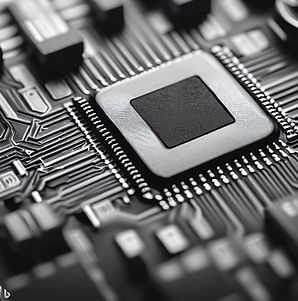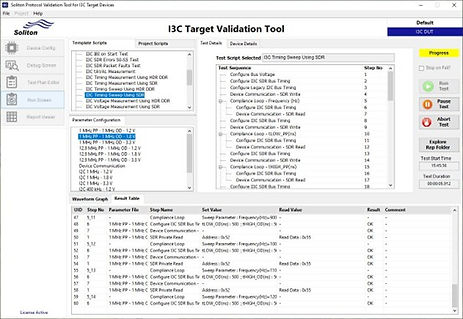Soliton 數位協定自動化驗證方案 - I3C
Soliton Technologies 是一家專注於數位協定驗證解決方案的公司,特別是在 MIPI I3C® 協定方面。其 I3C Protocol Validation Suite 利用 NI 的 PXI 平台 ( PXIe-6570 / 6571 ),提供自動化的功能、時序和電氣符合性測試,涵蓋 SDR、HDR-DDR 模式、動態位址分配、In-Band Interrupts 等功能,並支援錯誤注入與容錯測試,協助半導體公司快速驗證產品的協定相容性。

Soliton 數位協定驗證方案
-
Device Read/Write
-
Interrupts
-
Device Addressing, etc.

Soliton 數位協定驗證方案軟體介面
I3C 協定簡介
-
MIPI I3C® 是一種可擴展的中速公用與控制匯流排,廣泛用於手機、穿戴式裝置與汽車電子
-
目標在於簡化周邊元件與應用處理器的連接,提升整合效率並降低成本。
驗證挑戰
-
隨協定與產品設計日益複雜,傳統手動驗證方法耗時費力,延後產品上市時程。
-
確保協定相容性與異常狀況容錯能力成為驗證關鍵。
Soliton I3C Validation Suite 優勢
-
基於 NI PXI 平台,提供自動化、即插即用的驗證工具。
-
支援時序與電氣規範驗證,並可測試容錯與異常回復能力。
-
自動產生完整測試報告,提升除錯與驗證效率。
-
用戶經驗顯示,可將驗證時間從數週縮短至數天。
Soliton I3C Validation Suite 組成
Soliton 的 I3C Validation Suite 是一套現成的驗證工具,搭載 NI PXI 平台,協助驗證裝置是否符合 MIPI I3C® 協定的時序與電氣規格。其組成包含以下元件:
-
NI PXIe 657x ─ 數位模式產生卡,搭配 PXIe 機箱架構
-
Soliton PVS 轉接板(Interposer Board)
-
示波器 ─ 執行電壓量測
-
Soliton I3C Validation Suite 軟體 ─ 支援 Windows 作業系統 (Windows 10)
MIPI I3C Protocal - Functional Coverage
-
I3C SDR Mode (15 MHz)
-
I3C HDR-DDR Mode (15 MHz)
-
Legacy I2C Mode (5 MHz)
-
Register Write (Legacy I2C/SDR/HDR)
-
Register Read (Legacy I2C/SDR/HDR)
-
Write N Bytes (Legacy I2C/SDR/HDR)
-
Read N Bytes (Legacy I2C/SDR/HDR)
-
Write N - Read N Bytes (Combined Format) (Legacy I2C/SDR/HDR)
-
Hot Join Funtional Test
-
IBI Funtional Test
-
IBI Interrupt Spacing Test
-
Clock Stalling
-
SDR and HDR DDR CCC Commands
-
Compliance Test Suite (CTS)
-
Dynamic/Statics Addressing
-
Direct and Broadcast CCC Commands
-
Start / Stop Coditions
-
Address Header and Transition Bit
-
HDR DDR Restart and Exit Patterns
-
Target Reset Patterns
-
Group Target Addressing
-
Induce SDR Errors (S0-S5)
-
Induce HDR / DDR Errors
-
Skip Start / Stop / Repeated Start
-
Skip HDR Restarts / HDR Exit
-
Add Clock from Address / data bytes
-
Skip Clock from Address / data bytes
-
Induce Parity / Preamble Errors
-
Induce Error in CRCS Calculation
-
Any Custom Faults in SDR / HDR DRR Transactions and can Check if the Slave is able to Recover from the Faults
MIPI I3C Protocal - Parametric Coverage
-
fSCL - SCL Clock Frequency
-
tSU - STA - Setup Time for Repeated Start
-
tHD - STA - Hold Time for a (Repeated ) Start
-
tLow, tDIG_L - SCL Clock Low Period
-
tHIGH, tDIG_H - SCL Clock High Period
-
tSU - DAT - Data Setup Time
-
tHD - DAT - Data Hold Time
-
trCL - SCL Single Rise Time
-
tfCL - SCL Single Fall Time
-
trDA - SDA Single Rise Time
-
tfDA - SDA Single Fall Time
-
tSU_STO - Setup Time for Stop
-
tBUF - Bus Free Time Between a Stop and a Start
-
tSPIKE - Pluse Width of Spikes to Supress
-
tLOW_OD, tDIG_OD_L-Low Period of SCL Clock
-
tHIGH_OD, tDIG_OD_H-High Period of SCL Clock
-
tfDA_OD - Fall Time of SDA Signal
-
tSU_OD - Data Setup Time During Open - Drain Mode
-
tCAS - Clock after Start Condition
-
tCBP - Clock before Stop Condition
-
tAVAL - Bus Available Condition
-
tIDLE - Bud Idle Condition
-
fSCL - SCL Clock Frequency
-
tLOW_PP, tDIG_L - SCL Clock Low Period
-
tHIGH_PP, tDIG_H - SCL Clock High Period
-
tSCO - Clock in to Data out for Slave
-
tCR - SCL Clocl Rise Time
-
tCF - SCL Clocl Fall Time
-
tHD_PP - SDA Signal Data Hold in Push - Pull Mode
-
tSU_PP - SDA Signal Data Setup in Push - Pull Mode
-
tCASr - Clock after Repteated Start Condition
-
tCBSr - Clock before Repteated Start Condition
-
VIL - Low-Level Input Voltage
-
VIH - High-Level Input Voltage
-
Vhys - Schmitt Trigger Input Hysteresis
-
VOL - Output Low Level
-
VOH - Output High Level